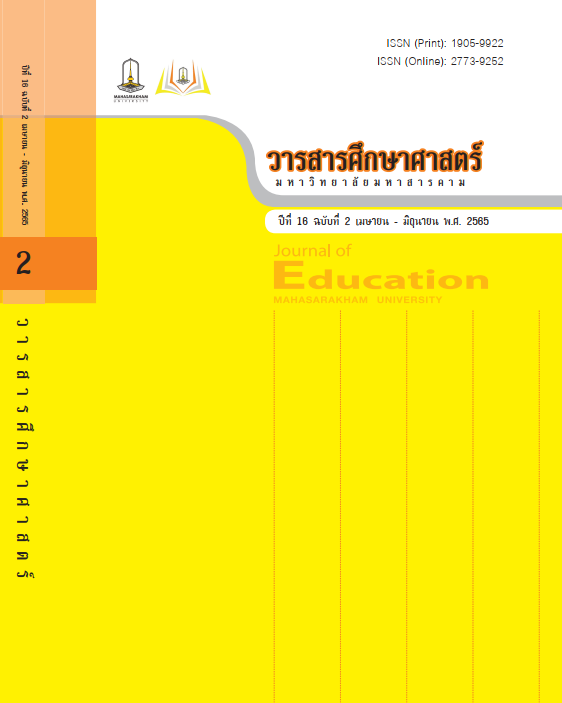Effectiveness of MS Teams-Based Learning and Teaching Management in Virtual Classroom for Introduction to Demography
Main Article Content
Abstract
The objectives of this research were to evaluate the virtual classroom teaching and learning management with microsoft teams program and to investigate student’ behavior towards teaching and learning, including to examine the achievement of virtual classroom teaching with microsoft teams. Data were collected from students enrolled in Introduction to demographic courses. Additionally, the research instruments were microsoft virtual classroom teaching assessment form, the student behavior assessment form for teaching and learning management analyzed by statistical percentage, mean, standard deviation, and the students’ achievement test analyzed by Statistical dependent t-test. Although the students employ smart phones to study, moreover they were facing with problems the lack of computer equipment and internet connection. The satisfaction scores in teaching virtual classrooms with MS teams program were only at moderate level. They thought that there should be more teaching in the real classroom than in the virtual classroom. However, they expressed the kindness each other, the interest in answering questions, and interactions with teachers. Moreover, it was found that they have higher learning achievements of learners, and achieve the expected learning outcomes of the course, as well.
Downloads
Article Details

This work is licensed under a Creative Commons Attribution-NonCommercial-NoDerivatives 4.0 International License.
References
กชพรรณ นุ่นสังข์, วิภาวรรณ ชะอุ่ม เพ็ญสุขสันต์, สายฝน เอกวรางกูร. (2562). การพัฒนาการจัดการเรียนการสอนออนไลน์แบบเปิดสำาหรับมหาชน (MOOC) ในรายวิชาจิตวิทยาพัฒนาการวัยสูงอายุ และจิตวิทยาพัฒนาการวัยรุ่น. Walailak Procedia 2019; (8). การประชุมวิชาการระดับชาติ สารสนเทศศาสตร์ วิชาการ ครั้งที่ 1 วันที่ 25-26 มิถุนายน 2562.
ชโรชีนีย์ ชัยมินทร์. (2562). MOOC: เพื่อการเรียนรู้ตลอดชีวิตในศตวรรษที่ 21. วารสารมนุษยศาสตร์และสังคมศาสตร์มหาวิทยาลัยราชภัฏเชียงใหม่, 1(1): 46-70.
ฐาปนีย์ ธรรมเมธา. (2557). โครงการตำาราอีเลิร์นนิง โครงการมหาวิทยาลัยไซเบอร์ไทย อีเลิร์นนิง: จากทฤษฎีสู่การปฏิบัติ e-Learning: from theory to practice. กรุงเทพฯ: สำนักงานคณะกรรมการการอุดมศึกษา.
ณวัฒน์ นันทะเสน และรักถิ่น เหลาหา. (2561). รายงานวิจัยเรื่องการพัฒนารูปแบบการเรียนการสอนด้วยเว็บเควสท์ โดยใช้ห้องเรียนเสมือนจริงร่วมกับโครงงานเป็นฐานเพื่อพัฒนาทักษะการเรียนรู้ในศตวรรษที่ 21 สำหรับนักศึกษาในระดับอุดมศึกษา. มหาสารคาม: มหาวิทยาลัยราชภัฏมหาสารคาม.
เดชดนัย จุ้ยชุม และคณะ. (2559). การพัฒนาผลสัมฤทธิ์ทางการเรียนเรื่อง ทักษะการคิดของนักศึกษาในรายวิชาทักษะการคิด (Thinking Skills) รหัสวิชา 11-024-112 ภาคเรียนที่ 1 ปีการศึกษา 2558 ด้วยการเรียนรู้แบบมีส่วนร่วม (Active Learning). วารสารมหาวิทยาลัยนราธิวาสราชนครินทร์ สาขามนุษยศาสตร์และสังคมศาสตร์, 3(2), 47-55.
นีรนาท จุลเนียม. (2562). การพัฒนารูปแบบการเรียนร่วมกับสื่อเครือข่ายสังคมออนไลน์เพื่อพัฒนาทักษะการคิดอย่างมีวิจารณญาณของนักศึกษาระดับบัณฑิตศึกษา โดยใช้กระบวนการเรียนรู้แบบ MIAP. วารสารศึกษาศาสตร์ มมร คณะศึกษาศาสตร์ มหาวิทยาลัยมหามกุฏราชวิทยาลัย, 7(2), 319-334.
วริศา วรวงศ์, พูลทรัพย์ ลาภเจียม, วราภรณ์ บุญยงค์. (30 ธันวาคม 2563). การพัฒนารูปแบบการเรียนการสอนด้วยสื่ออิเล็กทรอนิกส์ของผู้เรียนรายวิชาการพยาบาลมารดาทารกและผดุงครรภ์ 1. วารสารสมาคมพยาบาลแห่งประเทศไทย ในพระราชูปถัมภ์สมเด็จพระศรีนครินทราบรมราชชนนี สาขาภาคเหนือ, 25(2), 13-25. สืบค้นเมื่อ 6 ตุลาคม 2564, จาก http://www.natnorth.org/index.php?op=journal
วิทยา วาโย อภิรดี เจริญนุกูล ฉัตรสุดา กานกายันต์ จรรยา คนใหญ่. (2563). การเรียนการสอนแบบออนไลน์ภายใต้สถานการณ์แพร่ระบาดของไวรัส COVID-19: แนวคิดและการประยุกต์ใช้จัดการเรียนการสอน. วารสารศูนย์อนามัยที่ 9, 14(34), 285-298.
ศราวุธ เรืองสวัสดิ์, ปภาสินี แซ่ติ๋ว, ปิยะรัตน์ ชูมี. (2563). ผลการจัดการเรียนรู้แบบผสมผสานต่อทักษะการเรียนรู้แห่งศตวรรษที่ 21 สำหรับนักศึกษาพยาบาลศาสตร์ วิทยาลัยพยาบาลบรมราชชนนีสุราษฎร์ธานี. วารสารพยาบาลทหารบก, 21(1), 235-244.
สำานักงานเลขาธิการสภาการศึกษา กระทรวงศึกษาธิการ. (2560). แผนการศึกษาแห่งชาติ พ.ศ.2560-2579. กรุงเทพฯ: สำานักงานเลขาธิการสภาการศึกษา กระทรวงศึกษาธิการ.
Bonwell, C.C. & Eison, J.A. (1991, December 11). Active Learning: Creating Excitement inthe Classroom. Retrieved July 15, 2021, from https://eric.ed.gov/?id=ED336049
Friel, L.L. (2000, October 12). The Information research process with low-achieving freshmen using Kuhlthau’s Six-Stage Model. Retrieved June 6, 2021, from http://ala.org/aasl/SLMR/diss_grover1.html
Gedera, Dillani, S.P. (2014). Students’ experiences of learning in a virtual classroom. International Journal of Education and Development using Information and Communication Technology (IJEDICT), 10(4), 93-101.
Hadley, N.J. (1998, April 15). The Effects of technology support system on achievement and attitudes of preservice teacher. Retrieved July 15, 2021, from https://www.proquest.com/docview/304461009?accountid=28431
Hussin WNTW, Shukor HJ, Shukor NA. (2019). Online interaction in social learning environment towards critical thinking skill: A framework. Journal of Technology and Science Education, 9(1), 4-12.
Poston, Janice; Apostel, Shawn; and Richardson, Keith. (2020, June 15) “Using microsoft teams to enhance engagement and learning with Any Class: It’s Fun and Easy”. Pedagogicon Conference Proceedings. 6. Retrieved October 15, 2021, from https://encompass.eku.edu/pedagogicon/2019/guidinggrading/6
Relan, A.and Gillani, B.B. (1997, December 15). Web-based information and the traditional classroom: Similarities and differencee. In khan, B.H., (Ed). Web-Based Instruction. Englewood Cliffs. New Jersey: Educational Technology Publications. Retrieved July 15, 2021, from https://www.kroobannok.com/133

